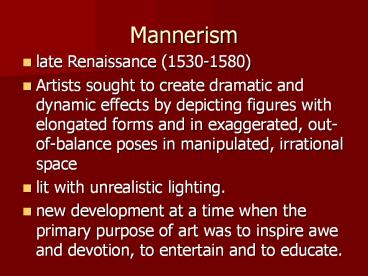Mannerism - PowerPoint PPT Presentation
Title:
Mannerism
Description:
Mannerism late Renaissance (1530-1580) Artists sought to create dramatic and dynamic effects by depicting figures with elongated forms and in exaggerated, out-of ... – PowerPoint PPT presentation
Number of Views:247
Avg rating:3.0/5.0
Title: Mannerism
1
Mannerism
- late Renaissance (1530-1580)
- Artists sought to create dramatic and dynamic
effects by depicting figures with elongated forms
and in exaggerated, out-of-balance poses in
manipulated, irrational space - lit with unrealistic lighting.
- new development at a time when the primary
purpose of art was to inspire awe and devotion,
to entertain and to educate.
2
Jacopo Bassano The Miraculous Draught of Fishes
(1545)
3
Jan Gossart Title of Painting Unknown
4
Barocci The Nativity (1526-1612)
5
Baroque Art
- The Council of Trent, in which the Roman Catholic
Church answered many questions of internal reform
raised by both Protestants and by those who had
remained inside the Catholic Church, addressed
the representational arts by demanding that
paintings and sculptures in church contexts
should speak to the illiterate rather than to the
well-informed.
6
- The Catholic Church wanted art that would inspire
and move the worshiper - It also wanted art that would sell the Catholic
religion - Church artworks should be a clear, intelligible
subject realistically interpreted in order to
stimulate piety. - This was part of the reason that the artwork
turned towards naturalism, becoming emotionally
engaging and intense.
7
- Baroque art is a successor to mannerism
- It is grandiose
- It is a three-dimensional display of life and
energy - Baroque art tends to focus on Saints, the Virgin
Mary, and other well known bible stories - Baroque art is characterized by great drama, rich
deep color, and intense light and dark shadows
8
- As opposed to Renaissance art, which usually
showed the moment before an event took place,
Baroque artists chose the most dramatic point,
the moment when the action was occurring.
9
CaravaggiCrucifixion of Peter(1601)Italian
Artist
10
Caracci Flight into Egypt (1603) Italian Artist
11
Georges de La Tour St. Joseph
Carpenter(1642)French Artist
12
Rembrandt Christ in the Storm on Lake of Galilee
(1632) Dutch Artist
13
Not all baroque art was religious in nature.
Rembrandt painted Abduction of Europa.Europa was
a Phoenician woman in Greek mythology, from whom
the name of the continent Europe has ultimately
been taken.
14
- The princess Europa is carried away from her
companions and across the sea by the god
Jupiter in the guise of the white bull to the
distant land that would bear her name.
15
Rembrandt Abduction of Europa (1632) Dutch Artist
16
Francisco de Zurbarán(1627)Spanish Artist
17
Peter Paul Rubens (1571-1640)
- The most popular and prolific Flemish and
European painter of the 17th century. - Because many of his paintings feature
full-figured, voluptuous women, the word
"Rubenesque" (meaning plump or fleshy, yet not
"fat," and used exclusively to describe women) is
derived from his last name.
18
Peter Paul Rubens Allegory on Charles V as Ruler
of the World Flemish Painter
19
Gianlorenzo Bernini (1598-1690)Italian Artist
- Sculptor
- Architect
- Roman fountains, part public works and part Papal
monuments, were among his most gifted creations - Also revolutionized marble busts, lending
glamorous dynamism to once stony stillness of
portraiture.
20
BerniniMarble Bust of Pope Urban VIII
(1623-1624)
21
BerniniBronze Bust of Pope Urban
VIII(1632-1633)
22
Bernini David (1623-1624)Considered to be among
the first truly baroque statues. Note that
David is poised to throw the rock.
23
Spanish Baroque ArchitectureSantiago Cathedral
24
German Baroque Architecture Kaisersaal, or
Emperors Hall, of the Residenz, shown on next
slide, is an oval reception room with a domed
ceiling and frescoes painted by Italian master
Giovanni Battista Tiepolo. (1700s)
25
(No Transcript)
26
BerniniPiazza and CollonadeSt. PetersRome
27
French Baroque Architecture Palace of Versailles
- Built 1660-1685
- In the Hall of Mirrors
- The German Empire was proclaimed on January 18,
1871 following the defeat of France in the
Franco-Prussian War. - It was also here that Germany signed the 1919
Treaty of Versailles, officially ending World War
I.
28
(No Transcript)
29
(No Transcript)
30
Versailles Hall of MirrorsLocated on the first
floor of the palace, it takes its name from the
357 LARGE mirrors that face windows on an
opposite wall.

